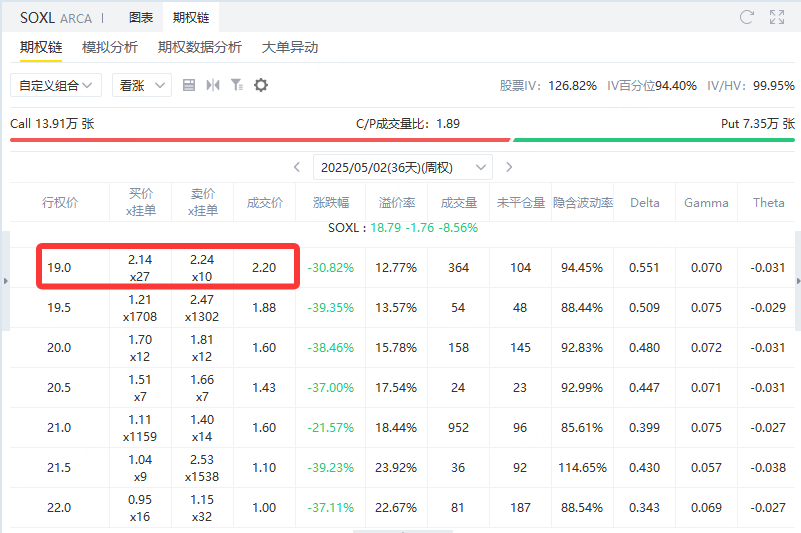Semiconductors plummet! Is the time to buy the bottom of SOXL coming?
Overnight, a report revealing dramatic changes in the computing power market triggered a plunge in U.S. AI concept stocks. On March 26, TD Cowen, a subsidiary of TD Securities, released a report stating that Microsoft has recently canceled and postponed data center leases on a large scale in the United States and Europe, giving up more than 2GW of capacity due to the oversupply of computer clusters. Affected by this, U.S. chip stocks have fallen one after another-the Philadelphia Semiconductor Index fell about 3.3%, Nvidia closed down more than 5.7%, and even ultramicro computers fell nearly 8.9% overnight. While market sentiment was sluggish, Google and Meta quickly filled the vacancy left by Microsoft's lease withdrawal, showing that the total demand for data centers is still growing. However, as hyperscale data centers are transitioning to higher densities, equipment orders have experienced a short-term slowdown, and supply chain decisions have been delayed. This series of factors has temporarily frustrated market confidence in semiconductor and AI concept stocks.
For investors who have been optimistic about the fundamentals of the semiconductor and computing power markets for a long time, this plunge provides an excellent opportunity to buy bottoms on the left. When intervening at this low level, using the bull market bullish spread strategy can not only capture the leverage benefits brought by future rebounds, but also effectively control risks.
The report shows that Microsoft has canceled or postponed multiple data center leases in the United States and Europe in the past six months, mainly because it no longer supports incremental OpenAI training workloads, thereby retaining core market capacity. This strategy not only exposes the problem of data center oversupply, but also provides opportunities for other operators to fill the market gap. At the same time, OpenAI is seeking to expand capacity through third-party data centers, and even plans to launch multiple "Stargate" projects. The long-term capacity demand is expected to exceed 6GW. The short-term slowdown in equipment orders due to the upgrade of supercomputing architecture has made the market full of doubts about the prospects of the supply chain.
The combined effect of these factors put the technology sector and AI concept stocks under pressure for a while, and chip stocks generally fell. Under such circumstances, the current price of SOXL, as a leveraged ETF in the semiconductor sector, has fallen to US $18.79, providing investors with an opportunity to buy bottoms.
Introduction to Bull Call Spread Strategy
The bull market call spread strategy is a classic options trading technique, which is suitable for scenarios where the underlying asset is expected to rebound, but it is hoped to participate in the upward market while controlling risks. The basic operation process is as follows:
Buying a call option: Choose a call option with a lower strike price to gain positive upward exposure to the underlying asset.
Sell a call option: Choose a call option with a higher strike price, collect premium by selling it, partially offset the cost, thereby reducing the net expense.
The maximum loss of this combination strategy is limited to the expenditure of net premium, while the maximum profit is limited by the exercise spread, which not only ensures the limitation of risks, but also allows you to enjoy the benefits brought by the leverage effect when the market rebounds.
SOXL Options Case
In the current$Triple Long Semiconductor ETF-Direxion Daily (SOXL) $Against the background of low levels, we choose the following specific contracts to build a bull market bullish spread strategy:
Buying a call option
Strike price: $19
Expiration date: May 2, 2025
Premium: $220
Sell a call option
Strike price: $25
Expiration date: May 2, 2025
Premium: $45
In this strategy, you need to pay $220 for buying an option with a strike price of $19, while selling an option with a strike price of $25 can get a $45 premium. Thus, the net cost is:
Net premium = 220 − 45 = $175
This $175 is the maximum loss of this strategy (regardless of transaction fees).
The strike spread between the two options is:
25 − 19 = $6
When the SOXL price exceeds $25 at expiration, both options are exercised, and the maximum profit of the strategy at this time is the exercise spread minus the net cost. If the standard of each contract is 100 shares, the calculation of actual returns and risks needs to be multiplied by the number of contracts. The specific profit calculation formula is as follows:
Maximum Gain = ($6 × 100) − (Net premium × 100)
Here, the maximum return is limited by the upper limit of the option strike spread, but compared with direct buying of stocks or naked options trading, the bull market call spread strategy can better control costs and downside risks.
epilogue
The storm in the data center market and the news of Microsoft's large-scale lease withdrawal triggered a general decline in the technology sector, but it also provided a rare bargain-hunting opportunity for investors who are optimistic about the long-term fundamentals of semiconductors. Using the bull market bullish spread strategy, this strategy can not only capture the possible future rebound gains, but also limit the maximum loss to a controllable range, providing investors with a stable layout plan that takes into account risks and returns in market fluctuations.
Disclaimer: Investing carries risk. This is not financial advice. The above content should not be regarded as an offer, recommendation, or solicitation on acquiring or disposing of any financial products, any associated discussions, comments, or posts by author or other users should not be considered as such either. It is solely for general information purpose only, which does not consider your own investment objectives, financial situations or needs. TTM assumes no responsibility or warranty for the accuracy and completeness of the information, investors should do their own research and may seek professional advice before investing.



